

Beten. Dagr. Dalia (mythology) Dalia is the goddess of fate in the Lithuanian mythology.
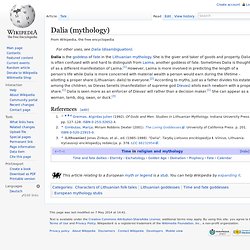
She is the giver and taker of goods and property. Dalia is often confused with and hard to distinguish from Laima, another goddess of fate. Sometimes Dalia is thought of as a different manifestation of Laima.[1] However, Laima is more involved in predicting the length of a person's life while Dalia is more concerned with material wealth a person would earn during the lifetime – allotting a proper share (Lithuanian: dalis) to everyone.[2] According to myths, just as a father divides his estate among the children, so Dievas Senelis (manifestation of supreme god Dievas) allots each newborn with a proper share.[1] Dalia is seen more as an enforcer of Dievas' will rather than a decision maker.[1] She can appear as a woman, lamb, dog, swan, or duck.[3] Elli. A depiction of Elli wrestling Thor (1919) by Robert Engels.
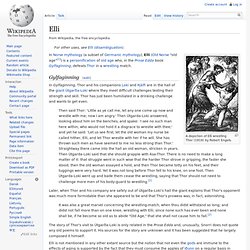
In Norse mythology (a subset of Germanic mythology), Elli (Old Norse "old age"[1]) is a personification of old age who, in the Prose Edda book Gylfaginning, defeats Thor in a wrestling match. Gylfaginning[edit] In Gylfaginning, Thor and his companions Loki and Þjálfi are in the hall of the giant Útgarða-Loki where they meet difficult challenges testing their strength and skill. Thor has just been humiliated in a drinking challenge and wants to get even.
Then said Thor: 'Little as ye call me, let any one come up now and wrestle with me; now I am angry.' Father Time. Detail of Father Time in the Rotunda Clock (1896) by John Flanagan, Library of Congress Thomas Jefferson Building, Washington, D.C.
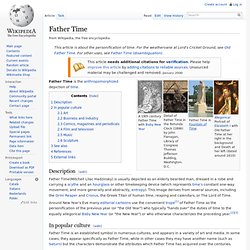
Allegorical Portrait of Elizabeth I with Old Father Time at her right in the background and Death at her left (dated around 1610) Father Time is the anthropomorphized depiction of time. Description[edit] In popular culture[edit] Art[edit] Laima. Laima (also Lama in Latvian) is a Baltic goddess of fate.[1] She was associated with childbirth, marriage, and death; she was also the patron of pregnant women.

Laima and her functions are identical to the Hindu goddess Lakshmi. In Latvia[edit] In the Latvian mythology, Laima and her sisters, Kārta and Dēkla, were a trinity of fate deities, similar to the Norse Norns or the Greek Moirai.[2] Laima makes the final decision on individual's fate and is considerably more popular. Lauma. Latvian: Lauma, Lithuanian: Laumė is a woodland fae, and guardian spirit of orphans in Eastern Baltic mythology.[1] Originally a sky spirit, her compassion for human suffering brought her to earth to share our fate.

In Lithuanian mythology[edit] Laumės are the very oldest goddesses of Lithuanian mythology. The image of these goddesses may have formed during the historical Mesolithic period, just after the Ice Age. Laumės could appear in form of animals – as she-goats, bears, brown bitches or mares. Later on, they had an anthropomorphic appearance: they usually had birds’ claws for feet, appear like women with a heads or lower body of she-goats, half-human / half bitch or half mare (like Centaurs), had only one eye (like Cyclops), had large breasts with stone nipples (pieces of Belemnitida found on ground were called Laumės nipples).
Matres and Matronae. The Matres (Latin "mothers"[1]) and Matronae (Latin "matrons"[1]) were female deities venerated in North-West Europe from the 1st to the 5th century AD.

They are depicted on votive objects and altars that bear images of goddesses, depicted almost entirely in groups of three, that feature inscriptions (about half of which feature Celtic names, and half of which feature Germanic names), that were venerated in regions of Germania, Eastern Gaul, and upper Italy (with a small distribution elsewhere) that were occupied by the Roman army from the first to the fifth century AD.[2] Information about the religious practices surrounding the Matres is limited to the stones on which their depictions and inscriptions are found, of which over 1,100 exist.[2] The Germanic matres have been connected with the later Germanic dísir, valkyries, and norns attested largely in 13th century sources.[1] Motifs[edit] Theories[edit] R. Norns. Norse mythology, Sjódreygil and the NornsFaroese stamps 2006 The Norns spin the threads of fate at the foot of Yggdrasil, the tree of the world.
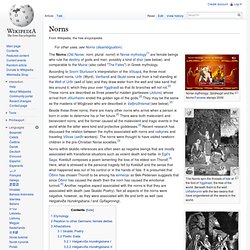
Beneath them is the well Urðarbrunnr with the two swans that have engendered all the swans in the world. Nortia. Ritual of the nail[edit] Nortia's attribute was a nail,[3] which was driven into a wall within her temple at Volsinii annually to mark the New Year.

The Roman historian Livy took note of the ritual: Cincius, an industrious researcher of antiquarian matters, confirms that at Volsinii nails are in evidence at the temple of the Etruscan goddess Nortia, fixed to mark the number of years.[4] Nótt. In Norse mythology, Nótt (Old Norse "night"[1]) is night personified, grandmother of Thor.
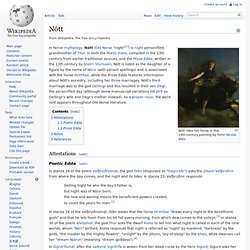
In both the Poetic Edda, compiled in the 13th century from earlier traditional sources, and the Prose Edda, written in the 13th century by Snorri Sturluson, Nótt is listed as the daughter of a figure by the name of Nörvi (with variant spellings) and is associated with the horse Hrímfaxi, while the Prose Edda features information about Nótt's ancestry, including her three marriages. Nótt's third marriage was to the god Dellingr and this resulted in their son Dagr, the personified day (although some manuscript variations list Jörð as Dellingr's wife and Dagr's mother instead).
As a proper noun, the word nótt appears throughout Old Norse literature. Attestations[edit] Skinfaxi and Hrímfaxi. "Dagr" (1874) by Peter Nicolai Arbo.
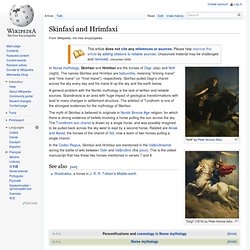
In Norse mythology, Skinfaxi and Hrímfaxi are the horses of Dagr (day) and Nótt (night). The names Skinfaxi and Hrímfaxi are bahuvrihis, meaning "shining mane" and "rime mane" (or "frost mane"), respectively. Sudz. Sumarr and Vetr. In Norse mythology, Sumarr (Old Norse "Summer"[1]) and Vetr (Old Norse "Winter"[2]) are personified seasons.
Sumarr and Vetr, personified, are attested in the Poetic Edda, compiled in the 13th century from earlier traditional sources, and the Prose Edda, written in the 13th century by Snorri Sturluson. In both, the two are given genealogies, while in the Prose Edda the two figure into a number of kennings used by various skalds. Tinia.
Some of Tinia's defining epithets are detailed on the Piacenza Liver, a bronze model of a liver used for haruspicy. Some of his epithets inscribed there include Tin Cilens, Tin Θuf and Tinś Θne. Inscriptions[edit] Tinia inscription on foreleg Tinia appears in several inscriptions, including: Itun turuce venel atelinas Tinas cliniiaras. This has given Venel Atelinas for the sons of Tin (ie: The Dioscuri[4]) On the bronze Chimera of Arezzo: Tinscvil A gift to Tinia References[edit] Jump up ^ de Grummond, Etruscan Myth, Sacred History and Legend, page 53^ Jump up to: a b Dennis, George (1848).
Ursitoare. The three Ursitoare, in Romanian mythology, are supposed to appear three nights after a child's birth to determine the course of its life. They are similar to the Greek Fates or Moirai. The Fates to baptize is part of Romanian tradition hundreds of years. Note the last few years "a physical materialization too" of this tradition through the show presented during the party name.